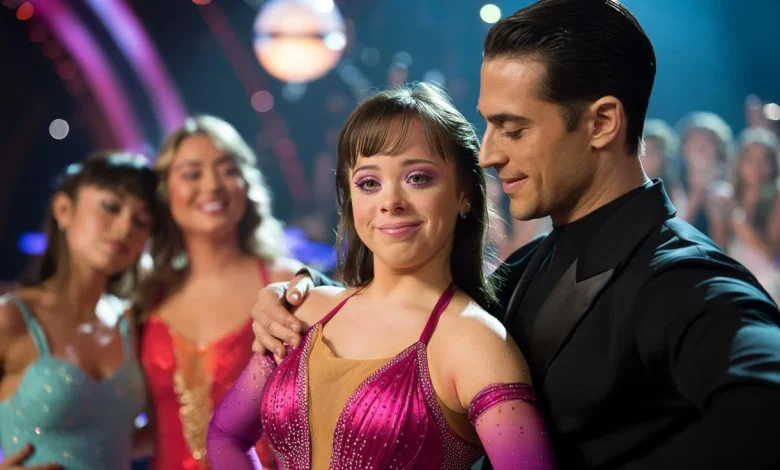Strictly first-night jitters or joy: did you misread Ellie Goldstein’s tears after her 17 points?

A Saturday cha-cha-cha, bright studio lights and a flurry of tweets left millions guessing about a tearful moment on Strictly.
Ellie Goldstein has now set the record straight after viewers mistook watery eyes for upset during her first live routine.
What happened on the night
Goldstein, who made history in 2023 as the first Vogue cover star with Down syndrome, stepped onto the Strictly Come Dancing floor on 27 September with professional partner Vito Coppola. Their cha-cha-cha drew a total of 17 points from the judging panel. Anton Du Beke praised her musical timing and suggested cleaner footwork would lift future scores.
The pair’s performance sparked loud applause in the studio and a growing wave of messages online. As the camera cut back to the contestants’ group area, viewers noticed Goldstein’s eyes glistening and her expression momentarily tighten.
Goldstein later explained that her eyes water after a long day under the lights and that she felt happy, not upset.
How viewers reacted in real time
On social media, supportive posts rolled in alongside worried questions. Some users asked whether Goldstein felt discouraged by 17 points, while others urged someone to offer her a hug. During a brief lull on camera, fellow contestant Harry Aikines-Aryeetey and pro dancer Karen Hauer were seen speaking to her gently, which added to the perception that she needed consoling.
Goldstein’s own message the next day
By Sunday morning, Goldstein had addressed the chatter on her official Facebook page. She said she was thrilled to be on the programme, thanked her family, agents and the Strictly team, and called the experience a dream. She emphasised that she feels strong, confident and fully herself when she dances.
Crucially, she clarified the moment that set social media buzzing: watery eyes, she said, sometimes follow long days of rehearsal and studio time. She reassured fans that she felt buoyant and grateful. She also repeated a personal point she has voiced before: she has Down syndrome, but it does not define who she is.
“I’m doing really well and feeling so happy,” she told followers, urging them not to mistake tired eyes for tears of distress.
The score, the judges and the week-one format
Seventeen points on opening night leaves ample room to climb as choreography grows more complex and technique settles. Craig Revel Horwood, Motsi Mabuse, Shirley Ballas and Anton Du Beke typically judge to a maximum of 40 combined. Week one traditionally sets a baseline rather than sealing anyone’s fate.
There was no elimination over the weekend. Producers confirmed that judges’ scores carry forward to next week, when audience votes return to the equation. Head judge Shirley Ballas also flagged a change to the programme’s voting system this series, the details of which will shape how early momentum is built.
- Date of debut: 27 September
- Dance: cha-cha-cha with Vito Coppola
- Judges’ total: 17 points
- On-air moment: watery eyes noticed by viewers
- Cast support: Harry Aikines-Aryeetey and Karen Hauer checked in
- Outcome: no elimination; scores roll into week two
- Ellie’s message: happy, confident, and loving the experience
Why the “tears” looked like sadness on live TV
Live entertainment often magnifies small physical reactions. Strong studio lighting dries the air, make‑up can irritate, and long rehearsal days tire facial muscles and eyes. Add adrenaline and the stop‑start nature of live broadcasting and a momentary glisten can read as a wobble. Viewers watch intently for micro‑expressions, especially when a celebrity’s narrative carries emotional weight.
Sports science and performance psychology both note that adrenaline spikes can cause damp eyes without any link to unhappiness. Dancers also manage breathing patterns as they recover post‑routine; a short, breath‑held pause, plus glitter and hairspray in the eyes, is a recipe for a shiny gaze that cameras amplify.
Performance fatigue, not disappointment, is often the simplest explanation for watery eyes under hot lights.
A broader conversation about representation
Goldstein’s appearance marks another step for disability representation in mainstream Saturday‑night entertainment. Her modelling career—capped by that groundbreaking Vogue cover—already challenged expectations about who gets seen on magazine stands. Strictly multiplies that visibility, placing her in households across the country every weekend.
With visibility comes a new kind of scrutiny. Viewers often overinterpret minor cues, especially with performers they feel protective towards. Advocates for disability inclusion argue that support should sit alongside the same artistic standards and critiques applied to everyone else. Goldstein’s own words mirror that view: she wants to be assessed on her dancing and personality, not reduced to a diagnosis.
How the show navigated the moment
The broadcast showed fellow contestants quietly checking in with Goldstein, a normal backstage kindness in a high‑pressure setting. That brief exchange seemed to reassure her, and the programme moved on without dwelling on the incident. The interaction was small, human and ordinary—exactly the sort of camaraderie Strictly has long celebrated.
Technique, next steps and what to expect
The cha‑cha‑cha can be unforgiving in week one. It demands precise foot placement, straightened knees on the beat and a settled rhythm through the hips. The quick feedback Goldstein received—tidier feet and sharper leg action—offers a straightforward path to extra points when she returns for week two. Expect targeted drills on weight transfer, timed Cuban breaks and cleaner New Yorkers to raise her baseline.
Coppola, a past finalist, typically shapes choreography that flatters a celeb’s strengths while sneaking in incremental technique. Viewers may see fewer side‑by‑side sync sections and more hold next week to stabilise timing. Strategically, a confident start to mid‑table scoring often pays off once the public vote arrives, because consistency builds trust.
Key detail
What it means for week two
17 points on debut
A platform to climb as precision improves
Judges flagged footwork
Focus on straight legs, cleaner steps, stronger finishes
Watery eyes on air
No cause for concern; manage rest and eye care in studio
Scores carried over
Early improvements have a compound effect on the leaderboard
Elsewhere on the dancefloor
Former Apprentice contestant Thomas Skinner leaned into a self‑deprecating paso doble, trading smoke for smiles. Meanwhile, Shirley Ballas’s note about a voting tweak signalled a series willing to adjust its mechanics to keep the competition lively. With nobody leaving this weekend, the pack remains bunched going into the first decisive shows.
Practical takeaways for viewers
When assessing early routines, look for timing and control before high‑risk tricks. A steady frame, clean finishes and musicality bank points across styles. If you plan to vote next week, consider progress, not just first impressions. Week one nerves often hide fast learners.
For those curious about the cha‑cha‑cha, try a simple at‑home drill: step side on count two, replace weight on three, close on four‑and‑one, keeping knees straight as the foot lands. Practising that rhythm for five minutes improves balance and helps you spot it on the show.
Support matters, but so does letting a dancer breathe: judge the routine, respect the person, and wait for the next step.





